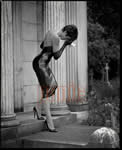Ilford Pays Tribute to Bob Carlos Clarke
 Ilford Press Release
Ilford Press Release
The words written by Owen Meredith 140-years ago: ‘Genius does what it must, and Talent does what it can’ seem to encapsulate the life and work of the passionate, some say obsessed, photographer and print maker Bob Carlos Clarke who sadly died on 25 March this year. The dark genius of Bob Carlos Clarke never left his work, whether it was photographing fetish-themed beautiful women in latex and rubber, advertising work for the likes of Levi, Smirnoff, Volkswagen and, paradoxically, Alliance & Leicester Building Society, or candid night-time shots of the nation’s youth at play. Carlos Clarke’s evocative use of black-and-white photographic artistry naturally brought him into contact with ILFORD whose film and paper he used for much of his work from the late 1980s. He undertook touring lectures for ILFORD and played to sell-out audiences wherever he went.
A natural highpoint in this relationship saw Carlos Clarke photograph the famous ILFORD Millennium calendar. Steven Brierley, sales director of ILFORD Photo, knew him well: “Bob was one of those rare characters who could truly be described as charismatic,” he says. “He was not someone with whom you exchanged a passing friendly word and then promptly forgot; his comments and questions betrayed an incisive mind which seemed to go the heart, if not the soul, of the matter.
“Certainly, he developed a reputation as the ‘enfant terrible’ of the photographic world with his uncompromising approach to what he found exciting, intriguing and artistically rewarding. That, though, was the nature of his genius.”
It was only in 1975, then aged 25, that Carlos Clarke burst onto the commercial photography scene having just completed his degree at the Royal College of Art, yet by 1979 he had produced his first book, The Illustrated Delta of Venus. Obsession followed in 1981 and The Dark Summer in 1985, both confirming his mould-breaking approach to photographing beautiful women in a style which extended beyond photography to represent a sea-change in attitudes toward culture and artistic representation.
Already he was displaying a degree of understanding which sometimes exposed itself in the flashing sparkle of an eye, or his considered opinions which seemed to flow off the cuff, yet embodied the depth, experience and gravitas of someone far older.
White Heat, Carlos Clarke’s 1990 book depicting the daily life of celebrity chef and restaurateur Marco Pierre White, illustrated another facet of his work - a cross between photojournalism and documentary, with a splash of raw realism highlighted by the black-and-white format. Again, this set a trend; this time for depicting the stark realities of life behind the glitz and the glamour.
This work emphasised Carlos Clarke’s ability to not only get inside his subject, but to capture its essence on film. White and Carlos Clarke were kindred spirits in many respects: both totally focussed on their respective creativity, both driven to go the extra step to achieve perfection, both totally intolerant of those who did not understand the addictive power of their genius.
It was a further 13 years before his next book, Shooting Sex, which he published himself in 2003. Subtitled ‘The definitive guide to undressing beautiful strangers,’ this book contains not only a wide selection of Carlos Clarke’s most erotic and evocative images, but also a biographic running commentary on his life, both personal and professional. Even after 30 years in the field, Carlos Clarke was still able to draw the comment from one reviewer: ‘He has an eye for glamour and beauty that is refreshingly unique: rich and honest, sexy and alive.’
It was a poke in the eye for those editors of the new breed of men’s magazine which rose in the ‘90s who decided the Bob Carlos Clarke name was too closely associated with what was considered a passé celebrity style. In fact, he had already proved his point by using a pseudonym ‘Jackal’ to submit work which was lapped up across the board.
“Bob Carlos Clarke was considered by many to take a deliberately iconoclastic approach to his work, but in fact he was an original thinker, unfettered by established styles and conventions,” comments Brierley. “Photography, art and the world at large needs such individuals - he will be sorely missed.”
Examples of Bob Carlos Clarke’s work can be viewed at www.bobcarlosclarke.com
